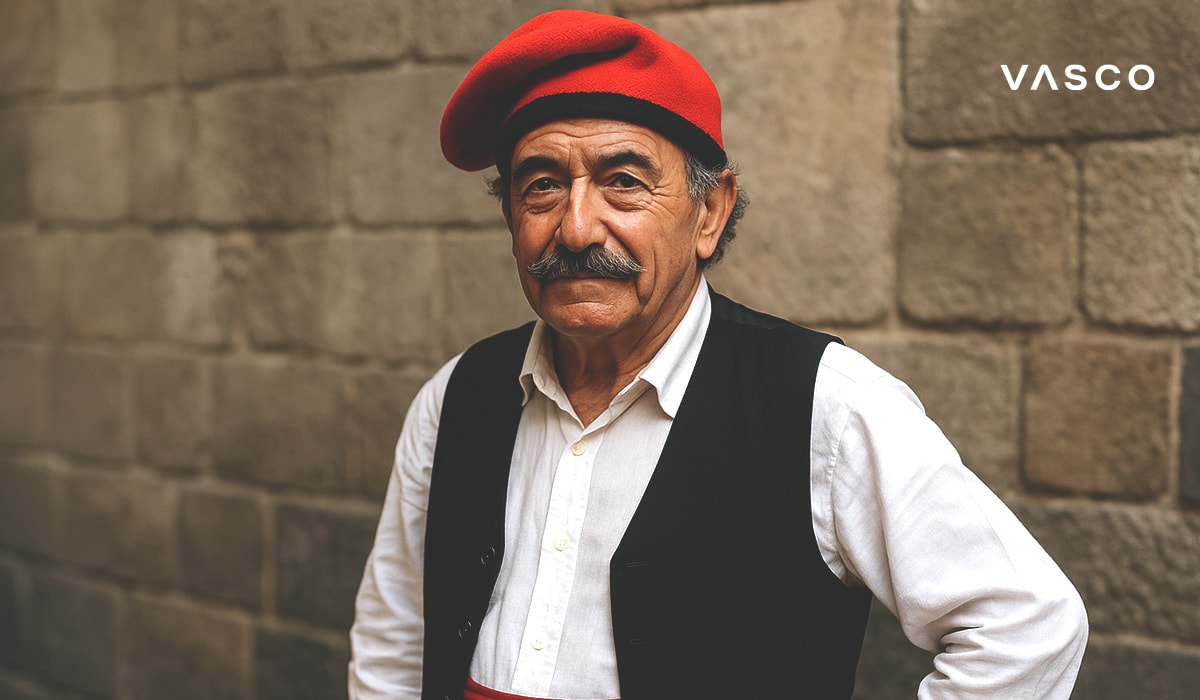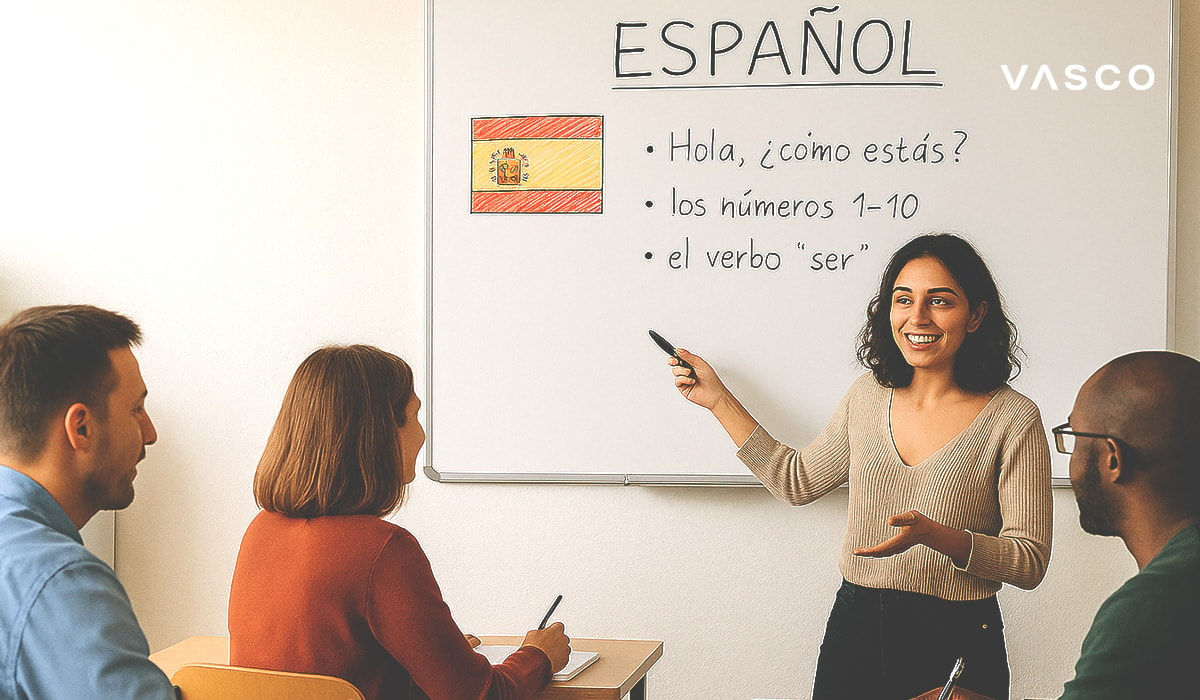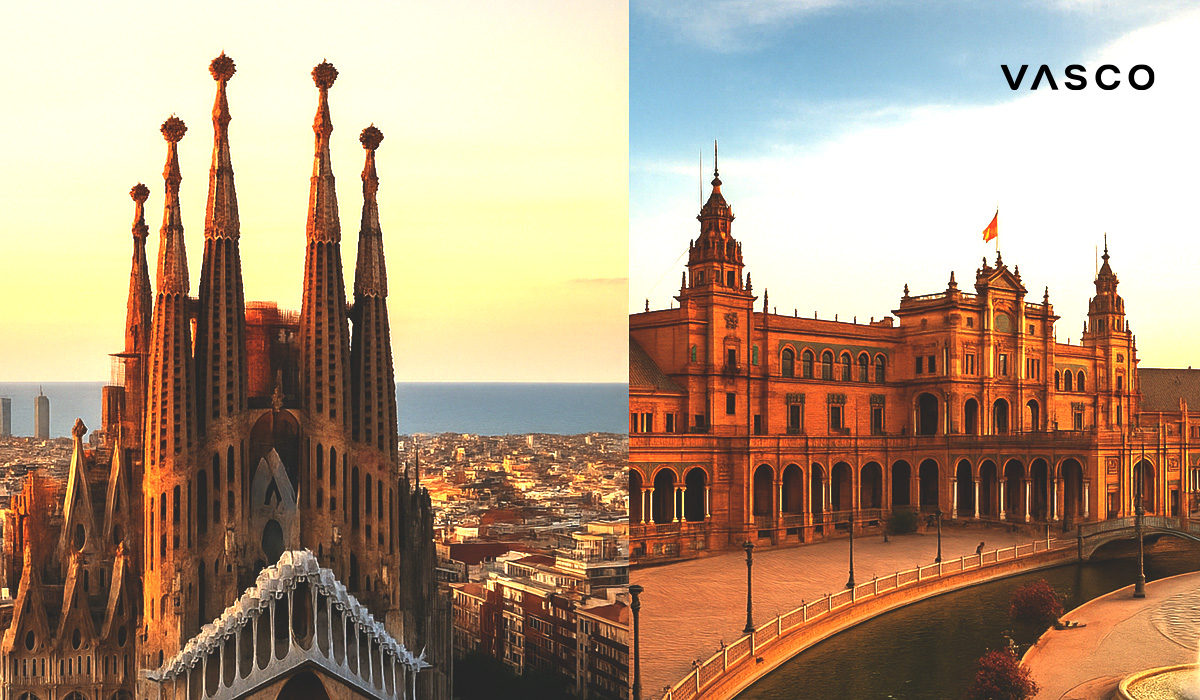If you’ve ever wondered about the languages spoken in Spain, you might be surprised to learn that Spanish isn’t the only official one in the country.
Table of Contents:
Catalan, a vibrant and widely-spoken tongue, plays a significant role in several Spanish regions. But what is Catalan language and what is the difference between Catalan and Spanish?
Many people assume these two languages are simply dialects of each other, but that’s far from the truth.
While both of them share some similarities due to their geographical proximity and shared Latin roots, they are completely separate tongues with distinct grammar, vocabulary, and pronunciation patterns.
So, What Is Catalan Language Exactly?
Catalan is a Romance language that evolved from Latin, just like Spanish, French, and Italian. It has its own rich literary tradition, cultural heritage, and around 4 million native speakers who use it in their daily lives.
Now, let’s see where Catalan is spoken.

Where is Catalan Spoken? A Geographic Overview
So, you’re probably asking “Where is Catalan spoken?” and how widespread it actually is.
The answer might surprise you – Catalan isn’t confined to just one region or even one country. This vibrant language crosses borders and spans across four different nations, making it one of Europe’s most geographically diverse regional languages.
FAQ:
How different is Spanish from Catalan?
Can you understand Spanish if you speak Catalan?
How similar are Catalan and Spanish?
What language is Catalan closest to?
What countries speak Catalan?
Is Barcelona Basque or Catalan?
Spain: The Catalan Heartland
Where is Catalan spoken in Spain? The answer covers more territory than most realize:
Catalonia (Catalunya)
- This is Catalan’s main stronghold, where it’s co-official with Spanish.
- In Val d’Aran, which is a moutain area in northwest Catalonia, Catalan even shares official status with Occitan.
The Valencian Community
- Here, Catalan is called “Valencian” and enjoys co-official status with Spanish.
- In spite of the name difference, most linguists and the Valencian Academy of Language think of Valencian and Catalan to be different names for the same tongue.
The Balearic Islands
- Catalan is a regional language of all four main islands (Mallorca, Menorca, Ibiza, and Formentera).
- Each island has its own dialect variations (for example, Mallorcan (Mallorquí), Minorcan (Menorquí), and Ibizan (Eivissenc))
- Catalan is co-official with Spanish.
La Franja (Aragon)
- A narrow strip along Aragon’s border with Catalonia.
- Catalan-speaking communities that have maintained their language despite being in a different autonomous community.
Carche (Murcia)
- A small region in southeastern Spain.
- Valencian-speaking inhabitants who trace their linguistic roots back centuries.
Beyond Spain’s Borders
What country speaks Catalan as its only official language? That would be Andorra:
Andorra
- This tiny country nestled in the Pyrenees makes Catalan its sole official language.
- About 80,000 residents, though many also speak Spanish and French.
- It is the only country where Catalan has exclusive official status.
France: The Roussillon region
- The Roussillon region (Pyrénées-Orientales department) in southern France, also called Northern Catalonia (The French name, Catalogne Nord).
- Catalan is recognized as a regional language but isn’t official. French is the only official language in this region.
Italy: A Mediterranean Surprise
- The city of Alghero on Sardinia’s northwest coast.
- Home to Algherese Catalan, a unique variant that’s been isolated for centuries.
- The Italian government has made effort to preserve this language by, for instance, including it in official documents and official communication.

The Big Picture: Catalan’s Reach
Where is Catalan spoken overall? Across approximately 68,000 square kilometers – that’s roughly the size of Ireland! About ten million people speak Catalan worldwide.
This geographic spread shows that answering the question “Where do they speak Catalan?” isn’t just about one region trying to maintain its identity – it’s about a language community that spans multiple countries and has survived centuries of political changes.
From the bustling streets of Barcelona to the quiet villages of Sardinia, Catalan continues to thrive in diverse settings across the Mediterranean world.
Now that we know more about this unique tongue, let’s dive deeper into answer to the question “What is Catalan language?”
How Different Is Catalan from Spanish?
If you’re wondering “How different is Catalan from Spanish?”, the answer might surprise you. While both languages come from Latin roots, the difference between Catalan and Spanish goes much deeper than you might expect.
“Is Catalan similar to Spanish” is a question many people ask, so let’s break down the main areas where these languages diverge.
Pronunciation: More Than Just an Accent
How different is Catalan from Spanish? It becomes immediately obvious when you hear them spoken. Here’s what sets them apart:
- Vowel complexity: Catalan has eight vowel sounds compared to Spanish’s five. This means Catalan speakers distinguish between open and closed vowels (like é/è and ó/ò), while Spanish keeps things simpler with consistent vowel sounds.
- Stress-dependent vowels: In Catalan, the letters “o,” and “e” actually change how they sound depending on whether they’re stressed or not. Spanish vowels? They usually stay the same.
- Consonant clusters: Catalan loves putting consonants together in ways that would make Spanish speakers need an extra vowel. It’s like Catalan is comfortable with consonant traffic jams that Spanish tries to avoid.
- Unique sounds: That distinctive “ç” in Catalan (pronounced like an “s”) and the softer “j” and “g” sounds give the language its characteristic flavor.
- Word linking: Catalan speakers often blend words together when speaking. In spite of the fact that blending words is common in all languages, connected & natural speech in Catalan produces a variety of unique sounds.
Grammar: Where Things Get Really Different
When it comes to Catalan vs Spanish examples in grammar, the difference between these languages becomes crystal clear:
- Catalan is sometimes considered to have preserved certain features from Latin that Spanish lost, especially in vocabulary and some grammatical structures.
- Catalan uses a periphrastic past tense called “passat perifràstic,” which is formed by conjugating the verb anar (“to go”) in the present tense plus an infinitive verb to express a completed past action. Spanish typically uses simple past tense for such expressions.
- Catalan has “hi” and “en” – words that show direction and origin but have no direct Spanish equivalents.
- In Catalan, you’ll say “la meva casa” (literally “the my house”), while Spanish drops the article and just says “mi casa.”
Vocabulary and Understanding: How Much Can You Actually Get?
How similar is Catalan to Spanish when it comes to understanding each other? It’s complicated:
- First of all, it’s worth noting that Catalan belongs to the Gallo-Romance subgroup, closer to French and Occitan than Spanish, which is Ibero-Romance.
- Both languages share many words because of their Latin heritage, but Catalan also borrowed from French and other northern Romance languages, creating some unique vocabulary.
- So, is Catalan similar to Spanish in terms of comprehension? A Spanish speaker hearing Catalan for the first time might catch the general idea of a conversation, but definitely won’t understand everything.
- Catalan sounds different depending on where you hear it. Barcelona Catalan has a different flavor than what you’d hear in Andorra, adding another layer to the difference between Catalan and Spanish.
Historical Roots: Why They’re So Different
How different is Catalan from Spanish? To answer that question, we need to find out more about history of both languages.
Here’s the backstory:
- Different evolutionary paths: While Spanish developed with the West Iberian language group, Catalan evolved alongside Gallo-Romance languages (think French family).
- Independent development: After the Roman Empire fell, these languages went their separate ways, picking up different influences and developing their own personalities over centuries.
Understanding these differences helps explain why differentiating Catalan from Spanish isn’t just about a few vocabulary changes – it’s about two languages that took completely different evolutionary paths from their common Latin ancestor.

Real-World Examples: Catalan vs Spanish Side by Side
Understanding the theory behind Catalan vs Spanish differences is one thing, but seeing them in action is where things get really interesting.
Let’s dive into some Catalan vs Spanish examples that show exactly what we mean when we talk about Catalan and Spanish language differences. These real-world comparisons will help you answer the question “Is Catalan similar to Spanish?”.
Basic Greetings and Everyday Phrases
Let’s start with what you’d hear on the street. Here’s where the difference between Catalan and Spanish becomes immediately obvious:
Greetings:
- Good morning: Catalan “Bon dia” vs Spanish “Buenos días”
- Good afternoon: Catalan “Bona tarda” vs Spanish “Buenas tardes”
- Good night: Catalan “Bona nit” vs Spanish “Buenas noches”
- How are you?: Catalan “Com estàs?” vs Spanish “¿Cómo estás?”
- Thank you: Catalan “Gràcies” vs Spanish “Gracias”
Notice how Catalan often drops the plural endings that Spanish keeps? This is just the beginning of their differences.
Numbers: Where Patterns Diverge
Numbers are great for showing Spanish vs Catalan contrasts because everyone needs to use them:
1-10 Comparison:
- One: Catalan “un/una” vs Spanish “uno/un/una”
- Two: Catalan “dos/dues” vs Spanish “dos”
- Four: Catalan “quatre” vs Spanish “cuatro”
- Five: Catalan “cinc” vs Spanish “cinco”
- Eight: Catalan “vuit” vs Spanish “ocho”
- Nine: Catalan “nou” vs Spanish “nueve”
See how different they sound? That “vuit” for eight and “nou” for nine show Catalan’s distinct personality.
Food and Dining: A Delicious Comparison
Nothing shows cultural differences like food vocabulary:
Common Foods:
- Bread: Catalan “pa” vs Spanish “pan”
- Water: Catalan “aigua” vs Spanish “agua”
- Wine: Catalan “vi” vs Spanish “vino”
- Fish: Catalan “peix” vs Spanish “pescado”
- Meat: Catalan “carn” vs Spanish “carne”
- Rice: Catalan “arròs” vs Spanish “arroz”
Restaurant Phrases:
- The menu, please: Catalan “La carta, si us plau” vs Spanish “La carta, por favor”
- I would like: Catalan “Voldria” vs Spanish “Quisiera”
- The bill: Catalan “El compte” vs Spanish “La cuenta”
Grammar in Action: Articles and Possessives
Remember those grammar differences we talked about? Here they are in real life:
Possessive Examples:
- My house: Catalan “La meva casa” vs Spanish “Mi casa”
- Your car: Catalan “El teu cotxe” vs Spanish “Tu coche”
- Our friends: Catalan “Els nostres amics” vs Spanish “Nuestros amigos”
See how Catalan always includes the article (“la,” “el,” “els”) before possessives? Spanish speakers find this really strange at first.
Pronunciation Differences You Can Hear
The difference between Spanish and Catalan isn’t just written – it’s very audible:
Words that look similar but sound different:
- Casa (house): In Catalan, the final ‘a’ is often reduced to a schwa sound, while Spanish keeps it crisp
- Pere (Peter): Catalan pronunciation is more like “PEH-reh” vs Spanish “Pedro” as “PEH-dro”
- Platja (beach): That ‘tg’ combination in Catalan creates a unique sound Spanish doesn’t have
Street Signs and Public Spaces
In Barcelona and other Catalan-speaking areas, you’ll see the Spanish vs Catalan difference everywhere:
Common Signs:
- Exit: Catalan “Sortida” vs Spanish “Salida”
- Entrance: Catalan “Entrada” vs Spanish “Entrada” (this one’s the same!)
- Hospital: Catalan “Hospital” vs Spanish “Hospital” (another match)
- Pharmacy: Catalan “Farmàcia” vs Spanish “Farmacia”
- Metro/Subway: Catalan “Metro” vs Spanish “Metro” (same again)
These examples show that while there are many Catalan language vs Spanish language differences, some words are identical or very similar, which is why Spanish speakers can sometimes guess the meaning even when they don’t know Catalan.
The Bottom Line: These real-world examples demonstrate that how similar Catalan to Spanish is varies dramatically depending on the context.
Some words are nearly identical, others are completely different, and the grammar patterns can throw Spanish speakers for a loop. It’s this mix of familiar and foreign that makes the difference between Spanish and Catalan so fascinating!

Learning Catalan language vs Spanish: Which Should You Choose?
Now that you’ve seen the difference between Catalan and Spanish in action, you might be wondering which language to tackle first. It’s a great question, and the answer depends on your goals, circumstances, and interests. Let’s break down the practical considerations for learning each language.
Global Reach and Practical Uses
Spanish: The Global Giant
- Spoken by over 500 million people worldwide across 20+ countries.
- Official language in most of Latin America and Spain.
- Huge job market opportunities in business, healthcare, education, and tourism.
- Massive amount of learning resources, from apps to university programs.
- More likely to be useful for international travel and business.
Catalan: The Regional Powerhouse
- About 10 million speakers concentrated in specific regions.
- Essential for living and working in Catalonia, Valencia, or the Balearic Islands.
- Strong cultural and economic significance in northeastern Spain.
- Can open doors to understanding other Romance languages.
- Less competition in the job market for Catalan speakers.
Learning Difficulty: What to Expect
Based on the Catalan vs Spanish examples we’ve covered, here’s the reality check:
Spanish for English Speakers:
- Generally considered “easier” due to consistent pronunciation rules.
- Five vowel sounds vs English’s complex vowel system.
- More predictable stress patterns.
- Tons of English-Spanish cognates (words that look similar).
- Simple past tense system compared to other Romance languages.
Catalan for English Speakers:
- More complex vowel system (8 vowels vs Spanish’s 5).
- Those tricky consonant clusters we mentioned earlier.
- More irregular verbs and complex grammar structures.
- Fewer learning resources available compared to Spanish
The Spanish-First Advantage: If you’re debating Spanish vs Catalan, learning Spanish first can actually help with Catalan later. The Catalan and Spanish language differences become easier to spot when you have Spanish as a foundation.

Learning Resources and Support
Spanish Learning Advantages:
- Duolingo, Babbel, Rosetta Stone – all major apps cover Spanish.
- Netflix has thousands of Spanish shows and movies.
- Spanish podcasts, YouTube channels, and online content everywhere.
- Universities worldwide offer Spanish programs.
- Easy to find conversation partners online.
Catalan Learning Reality:
- Fewer apps and online resources (though quality ones exist).
- Catalan TV and media available but more limited.
- Catalan language vs Spanish learning materials often assume Spanish knowledge.
- Some excellent university programs, especially in Catalonia.
- Smaller but passionate learning community.
Cultural and Personal Motivations
Why Choose Spanish:
- Connect with diverse cultures across multiple continents.
- Access literature from Spain and Latin America.
- Understand reggaeton, salsa, and Latin pop music.
- Travel more confidently in 20+ countries.
- Family heritage from Spanish-speaking countries.
Why Choose Catalan:
- Deep dive into Catalonian culture and identity.
- Understand the political and cultural dynamics of modern Spain.
- Access unique literature and cultural productions.
- Difference between Spanish and Catalan gives insight into language evolution.
- Stand out in a smaller, more specialized field.
The Best of Both Worlds Approach
Here’s a practical strategy many language learners use:
- Start with Spanish for the foundation and global utility.
- Add Catalan later when you have Spanish basics down.
- Use your Spanish knowledge to accelerate Catalan learning.
- The Catalan and Spanish language differences become learning tools rather than obstacles.
Remember, answering the question “How similar is Catalan to Spanish?” means learning one helps with the other – but they’re different enough that each offers unique rewards.
Your choice depends on your personal goals, timeline, and what excites you most about language learning!

Bridge the Gap with Technology: Vasco Translator
While you’re deciding between learning Catalan vs Spanish or working on mastering both, there’s a practical solution that can help you navigate these languages right now.
Vasco Translator V4 device is designed specifically for situations where you encounter multiple languages and need instant communication support.
Perfect for the Catalan-Spanish Challenge
Given the difference between Catalan and Spanish we’ve explored, having a reliable and universal translator becomes especially valuable when you’re traveling through regions where both languages are spoken. The Vasco AI translator handles both languages seamlessly, making it an ideal companion for:
- Voice translator: Simply speak in your language and get instant Catalan or Spanish translation spoken back to you. You can also choose other languages from 82 available in this functionality.
- Photo translator: Point your device at street signs, menus, or documents to translate Catalan and Spanish texts instantly. You can also choose other language from 112 available in this feature.
- Text transator: Perfect for those moments when you recognize a word but can’t remember its meaning. You can also choose other languages from 107 available in this feature.
- Multilingual chat: Communicate with locals in real-time, whether they’re speaking Catalan in Barcelona or Spanish elsewhere in the country.
Why This Matters for Catalan and Spanish
The Catalan and Spanish language differences we’ve discussed can be tricky to navigate in real-world situations.
You might find yourself in Barcelona wondering whether a sign is in Catalan or Spanish, or trying to communicate with someone who switches between both languages in the same conversation.
The Vasco portable translator takes the guesswork out of these interactions, letting you focus on enjoying your experience rather than puzzling over linguistic differences.
Whether you’re exploring the historic streets of Barcelona, ordering food in Valencia, or conducting business in Catalonia, having instant access to both languages removes the communication barriers and helps you appreciate the rich linguistic landscape of these regions.
Wrapping Up: Two Languages, Rich Diversity
Understanding the difference between Catalan and Spanish opens up a window into the incredible linguistic diversity that exists within Spain and beyond.
These aren’t just two similar languages with minor variations – they’re distinct languages with their own personalities, histories, and cultural significance.
The Catalan and Spanish language differences we’ve explored – from those tricky eight vowels in Catalan to the different ways of expressing possession – show how languages can evolve separately while sharing common roots. It’s a fascinating example of how human communities develop their own ways of communicating, even when they’re geographical neighbors.
Next time you hear someone speaking what sounds like Spanish but feels somehow different, you’ll know to listen more carefully. You might just be hearing Catalan – a language with nine million speakers, four countries, and centuries of rich cultural heritage behind every word.
Both languages deserve appreciation for what they bring to the world’s linguistic tapestry. The discussion on “Spanish vs Catalan” isn’t about choosing sides – it’s about recognizing the beautiful complexity of human language and culture.











